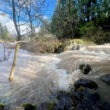Sean C. Morgan
Depending on how the City Council acts, city utility bills could increase by about $4 monthly at the most under three options presented last week to council members.
City staff presented three proposals for water rate increases and a proposal to increase the storm drainage fee during the council’s regular meeting on May 14.
For a water user of 600 cubic feet, the average amount used by residential ratepayers, the water portion of the bill could increase by about $1 to $2 or decrease by about $3 – depending on which option the council selects.
Councilors also are considering a $2 increase for storm water, which is included in utility bills. The current rate is $1 per month. Combined, at 600 cubic feet, a resident would see a decrease of $1.22 per month to an increase of as much as $4.03 per month.
Rate changes, if approved, take effect July 1.
The city last increased water rates last summer and sewer in January 2018. The city has never increased the storm drainage rate since it was created in 2006.
Under the current rate structure, all three-quarter-inch connections, including residential, commercial, industrial and bulk, have a base charge of $22.91 per month. The rate per 100 cubic feet is $7.86 for residential customers. The first 300 cubic feet is included with the base charge for residential accounts. The rate per 100 cubic feet is $7.78 for commercial users and $7.54 for industrial and bulk users.
Charges for water and sewer service are divided into a base charge and a commodity charge. The base charge is supposed to fund the fixed cost of the service while the commodity charge is supposed to fund the variable costs related directly to the treatment of water and wastewater.
Base charges are graduated for larger connections, to a maximum of $587.76 for 8-inch connections. The majority of commercial users have a three-quarter-inch connection. The city lists a total of 16 industrial and bulk connections, 260 commercial connections and 2,906 residential connections.
Under the first option, the base charge for three-quarter-inch connections would decrease to $19.99. The residential rate would increase to $9.25 per 100 cubic feet for residential services, $9.22 for commercial and $9.14 for industrial and bulk. Residences would continue to receive 300 cubic feet of water as part of the base charge.
Under the second option, the base charge would decrease to $19.99. The residential charge would increase to $11.64 per 100 cubic feet of water. The base charge would include the first 400 cubic feet, which means residents who use 600 cubic feet would be charged for 200 cubic feet plus the base charge, for example. The commercial rate would increase to $11.61 per 100 cubic feet and industrial and bulk user rates would increase to $11.51 per 100 cubic feet.
The third option returns to the rate structure, the same arrangement of base charge and commodity charge expenses, from two years ago, said Finance Director Brandon Neish.
That structure featured a larger difference in the commodity charge between residential accounts and commercial, industrial and bulk accounts. A higher residential rate was meant to cover the cost of the 400 cubic feet that the city began including with the base charge in the late 1990s.
The difference in commodity charges nearly disappeared in last year’s rate adjustment. A differential in commodity charges would reappear for industrial and bulk users by returning to the old rate structure in the third option.
In that option, the base charge would fall to $22.12. The commodity charge would increase to $8.80 per 100 cubic feet for residential customers. The base charge would include the first 300 cubic feet in the base charge for residential customers. The commercial rate would increase to $8.69 per 100 cubic feet, and the industrial and bulk rate would increase to $7.87 per 100 cubic feet.
The old structure is not completely replicated. Neish told The New Era that moving some Public Works staff to the new Internal Services Fund results in the expense moving from personnel to a transfer, likely keeping the base charge relatively lower and reducing the differences among the variable commodity charges.
Under the first two options, every residence using less than 600 cubic feet per month would see a reduction in their water bill, and in the third option, every residence using 300 cubic feet or less would see a decrease in their water bills.
These options are projected to raise $2.3 million in revenue, while the city is projecting $2.5 million in expenses for water in 2019-20, Neish said. Existing reserves will cover the difference.
In the city’s Storm Water Fund, projected expenses are $102,000, while at the current rate, the city projects $62,000 in revenue, Neish said. In 2006, an analysis concluded that the appropriate storm water drainage fee would be $4 per month per equivalent dwelling unit. After public input and council review, the council set the fee at $1 per month per EDU. That has not changed since its implementation.
In its five-year Capital Improvement Plan, the Public Works Department has identified two projects, totaling $165,000, to increase capacity in the storm drainage system and to develop a master plan.
The council will consider water and storm drainage rates at its next regular meeting, 6:30 p.m. Tuesday, May 28, in the Sweet Home Police Department conference room.
Present at the May 14 meeting were councilors Susan Coleman, Diane Gerson, Lisa Gourley, Mayor Greg Mahler, Cortney Nash and Dave Trask. James Goble was absent.
In other business, the council adopted an ordinance dissolving its Public Safety and Traffic Committee, following a third reading of the ordinance.




